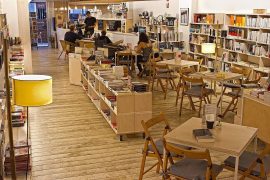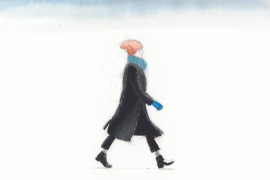[dropcap letter=”I”]
sla Negra, an hour and a half drive from Santiago, is not an isla —an island— nor is it negra —black. But in the whole vicinity, the name Pablo Neruda—not in fact his own name—gave the house he had built on this rocky shore has stuck. The first impression is purely olfactory—an acrid stench of fermented algae, iodine and salt from the sea that you smell before you see it. And the first thing you hear among the eucalyptus trees is the joyful song of the little zorzal—the thrush Neruda wrote a poem to—in which perhaps the poet’s spirit breathes.
Organic architecture, irregular, with lots of wood and with large windows, Neruda’s house at Isla Negra is as Mediterranean as the climate and the vineyards of Chile. It was built by a Catalan refugee, a member of the GATCPAC [Group of Catalan Architects and Technicians for the Progress of Contemporary Architecture], Germà Rodríguez Arias, who in a legendary Winter 1934 issue of the D’ací i d’Allà highbrow magazine devoted to the avantgarde illustrated with photographs of Ibizan houses an article by the not-yet-famous architect Josep-Lluís Sert, a friend of Miró’s, entitled precisely Architecture without style and without an architect.
Neruda’s house at Isla Negra is not a rationalist house—in the style of Le Corbusier—nor any of that. It is simply a house like a second skin, made without a preconceived plan, intuitively on dreams. Like the shanty Gala and Dalí bought from [Cadaqués fishmonger] Lídia for their Portlligat hideaway.
In fact, Neruda and Dalí function in the same way as nature: growing from the inside out, creating structures—paintings, houses, poems—through a certain order of the analogy of form.
This is the principle of the engaging magic practiced by the indigenous, the primitives, and poets: working by association and relationships or correspondence, invoking—or creating—what is not there by analogy with what is. And always ascending. So it can be said that Neruda progressed in a spiral, like the shells embedded in the cement floor of his house at Isla Negra.
The poet lived in this house as if a captain on the bridge of his ship. “Necesito del mar porque me enseña:/ no sé si aprendo música o conciencia:/ no sé si es ola o ser profundo/ o sólo ronca voz o deslumbrante/ suposición de peces y navíos.” [“I need the sea because it teaches me: / I do not know if I learn music or conscience: / I do not know if it is a wave or profound being / or just a husky voice or dazzling / supposition of fish and vessels.” From the poem El mar.]
Neruda wrote by hand, with green ink. Before and after writing, by hand and with green ink, he washed his hands as if following a strange ritual. Life, as we know, comes from water. And it leaves with water
The poet was lost to this sea, becalmed today, with malachite verse and lapis lazuli blues. Or in the dark and furious sea of the stormy sunsets, with a south wind and white with foam. And he himself was this ocean in constant change, the origin and the end of everything. “Siempre el mar con sus silencios y sus truenos, eternidades de que dispongo aquí cerca de mi ventana y alrededor de mi papel…” [“Always the sea with its silence and its thunder, eternities that I have here near my window and about my paper…” From the article ¿Por qué Joaquín Murieta?]

Neruda wrote by hand, with green ink. Before and after writing, by hand and with green ink, he washed his hands as if following a strange ritual. Life, as we know, comes from water. And it leaves with water. And it is also in the water where the poet feels like a fish at the centre of an astrolabe, a living kernel in the midst of primordial energy—as drawn in his own ex libris, now the emblem of his Foundation). That is why he is so much a poet that he could be considered a pre-Socratic Greek, a Mediterranean at the founding era of myths and cosmogonies.
Hölderlin was perhaps right when he said that “what remains is founded by the poets”. Neruda left everything at Isla Negra laden with meaning so it should be more enduring than his own existence.
He baptized everything, with the enchantment of the word, as if to blow life into each object. Animate the inanimate, is this not the secret strength of the shaman and of the Homeric bard who sings of the sea and the battles, the heroes and adventures of the human lineage?
Neruda is alive. And it is today, and not yesterday, when he speaks to us through his writing: “The old agave by my house took from the quick of its entrails its suicidal bloom. This plant, blue and yellow, gigantic and fleshy, lasted more than ten years by my door, growing to be taller than I. And now it blooms to die.”
Right in front of the house there is a rustic bell tower made with just a few wooden logs. “Me vine aquí a contar las campanas que viven en el mar, que suenan en el mar, dentro del mar. Por eso vivo aquí…” [“I came here to count the bells that live in the sea, that ring in the sea, within the sea. Thus here I live.” From the poem Aquí].
And now I imagine him ringing the bells as if warning sailors, confused by sirens’ songs, of the reefs. Or in this outlook, all glazed, he himself as a ship in a glass bottle. Neruda looks at this fisherman’s boat, with its hull painted green and red, labouring just a few meters from the beach. And the men who skin dive, with a simple plastic tube held between their teeth, down six or seven meters to tear from the submerged rocks such bivalve treasures as limpets or “locos” [Chilean abalone (Concholepas concholepas)], Chilean clams…
Between the house and the sea, of an impeccable navy blue, gleaming like a mirror, there is a large agave with its long flower spike—the “quiote”—already dry and black, an unequivocal sign of death. But Neruda is alive. And it is today, and not yesterday, when he speaks to us through his writing: “The old agave by my house took from the quick of its entrails its suicidal bloom. This plant, blue and yellow, gigantic and fleshy, lasted more than ten years by my door, growing to be taller than I. And now it blooms to die.”
I have always been particularly fascinated by this spectacular swansong of the agave. It is as much part of my own landscape and that of Noucentista [A Catalan cultural movement of the early 20th century] iconography. An American native, like [Catalan author Eugeni d’Ors’ character] La Ben Plantada, the agave takes from its heart a spear with grapes when it knows its life is over.
At Isla Negra everything is infused of Neruda’s mischievous, playful spirit. It is a fascinating house museum because it is the fruit of a great desire to build a place in the world for poetry. Neruda poetized everything. So each object here also has a meaning and a story. And everything seems to have been put in place with a deep sense of transcendence: the collections of shells and butterflies, miniature ships and figureheads, portraits of his friends, poets of all ages: Whitman—Whitman especially—and Keats, Pushkin and Mayakovsky, Garcilarso and Miguel Hernández, Edgar Allan Poe, Verlaine…
His name was Neftalí Reyes and he built his own myth. His father was a railwayman, a cheminot they say in French. The legend has it that as a child he had been poverty-stricken, but family photographs seem to belie this.. Neruda’s communism has passed away, his poetry remains. Did the poet himself not see it then when he wrote (in chapter 9 of his memoirs) that “life is stronger and more stubborn than its precepts. Revolution is life itself and the precepts seek their own coffin”?




















